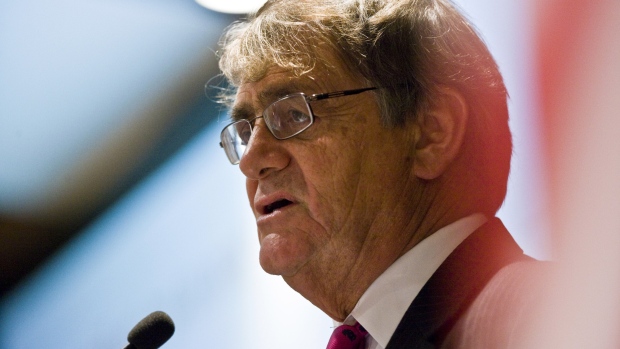(Bloomberg) -- The doyen of Australian interest-rate forecasters has shifted ground and now predicts the Reserve Bank will cut twice to counter slower growth and higher unemployment.
Bill Evans’s announcement Thursday that he expects the RBA to reduce the cash rate by a quarter-percentage point in August and November came less than an hour after employment data showed strong hiring in January. But underscoring the Westpac Banking Corp. chief economist’s sway in the market, the currency swiftly erased gains spurred by the jobs report.
Evans lowered his GDP growth forecast for this year and next to 2.2 percent from 2.6 percent and said the jobless rate would climb to 5.5 percent by late this year. “That makes a strong case for official rate cuts to cushion the downturn and, in turn, meet the RBA’s medium term objectives,” he said.
The Australian dollar dropped almost half a cent in response, having climbed to almost 72 cents after the employment data. It bought 71.66 U.S. cents at 2:54 p.m. in Sydney.
‘Large Stretch’
Evans argued that economic momentum “slowed dramatically” through 2018, estimating growth fell from an annualized 4 percent in the first half to about 1.5 percent in the second. For it to then shoot back up to 3 percent -- as the RBA forecasts this year -- “seems to be a very large stretch,” Evans said.
Central bank chief Philip Lowe shifted to a neutral from a tightening bias earlier this month, acknowledging the risks from tumbling house prices in Sydney and Melbourne on Australians’ confidence and spending. With wage growth weak and household debt high, the only way to improve the affordability of property is through cheaper borrowing costs, Evans said.
“Our estimates of the need to restore affordability and the impact of tighter lending standards on prices point to falls of around 5 to 10 percent in Sydney and Melbourne over the course of 2019,” he said. “Absent any policy response from the RBA we expect that further falls will be necessary in 2020 before stability in these markets will be achieved.”
Evan’s reputation was bolstered in 2011 when Australia’s mining-investment boom was generating rapid inflation, and economists and markets predicted the RBA would again raise what was already the developed world’s highest rate. The currency would soar to a post-float record of $1.10 in late July in anticipation.
Evans, returning from a trip to Europe during the bloc’s debt crisis, disagreed and switched from calling a hike to a cut. The central bank would opt against raising in August and then, as inflation quickly dissipated, it cut in November -- beginning a five-year easing cycle.
Jobs Strength
In 2019, the RBA maintains that a strong jobs market indicates the economy is in reasonable shape. Thursday’s data supports that view: the economy added about 39,000 jobs as full-time hiring surged, and unemployment only stayed at 5 percent because more people hunted for work -- another sign of strength.
In New South Wales, the nation’s largest state, the jobless rate fell to 3.9 percent. Yet that highlights a recurring problem Down Under -- falling unemployment just isn’t fueling the wage growth it once did. Pay rates have barely budged in the state.
Evans cited several risks to his outlook: a more resilient labor market -- he acknowledged the strength in today’s report; an unexpected jump in wages growth; the housing market stabilizing more quickly or a wealth effect failing to emerge from falling property; and even “over-estimating the appetite” of the RBA to respond to the environment he outlined.
Still, his view is that the RBA has changed its view on the housing market and that’s key to his belief that the cash rate rate will be 1 percent by year’s end.
Evans said a lower Australian dollar could also provide stimulus following the rate cuts, allowing the central bank to “resume its cautious stance.”
To contact the reporter on this story: Michael Heath in Sydney at mheath1@bloomberg.net
To contact the editors responsible for this story: Nasreen Seria at nseria@bloomberg.net, Chris Bourke, Malcolm Scott
©2019 Bloomberg L.P.








